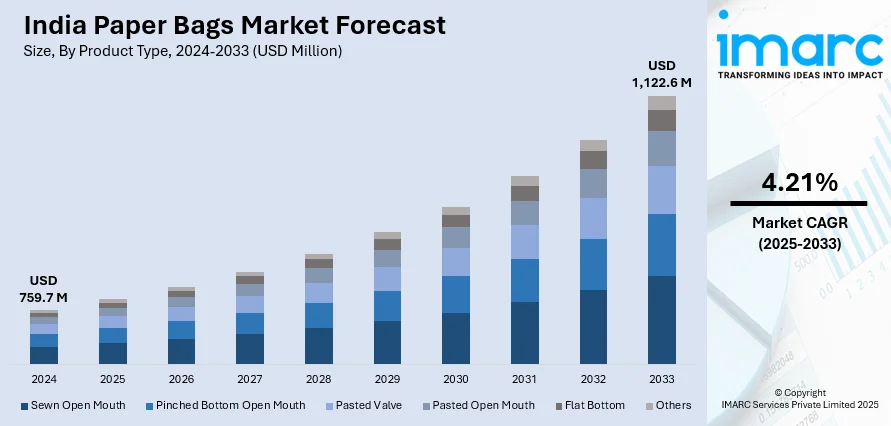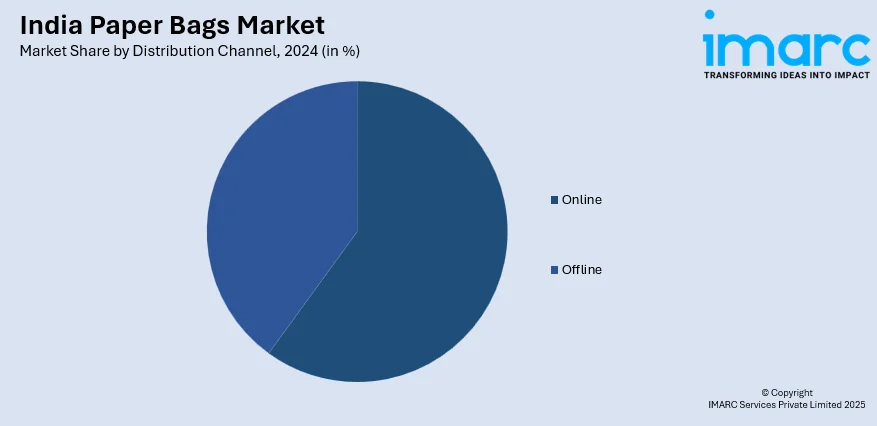
India Paper Bags Market Size, Share, Trends and Forecast by Product Type, Material Type, Thickness, Distribution Channel, End Use Industry, and Region, 2025-2033
India Paper Bags Market Summary:
The India paper bags market size reached USD 759.7 Million in 2024. The market is expected to reach USD 1,122.6 Million by 2033, exhibiting a growth rate (CAGR) of 4.21% during 2025-2033. The market growth is attributed to increasing environmental awareness, government regulations banning plastic, growing demand for eco-friendly packaging, rising consumer preference for sustainable products, the expansion of e-commerce, retail sector growth, and supportive policies promoting green initiatives.
Market Insights:
- Based on region, the market is divided into North India, West and Central India, South India, and East India.
- On the basis of product type, the market is categorized as sewn open mouth, pinched bottom open mouth, pasted valve, pasted open mouth, flat bottom, and others.
- Based on the material type, the market is divided into brown kraft and white kraft.
- On the basis of thickness, the market is segmented into 1 ply, 2 ply, 3 ply, and > 3 ply.
- Based on the distribution channel, the market is categorized as online and offline.
- On the basis of end use industry, the market is divided into food and beverages, pharmaceutical, retail, construction, chemicals, and others.
Market Size and Forecast:
- 2024 Market Size: USD 759.7 Million
- 2033 Projected Market Size: USD 1,122.6 Million
- CAGR (2025-2033): 4.21%
Paper bags are renewable and eco-friendly product variants of conventional bags used to hold purchases and packaging items. These bags are available in different forms, shapes, colors, and sizes that vary depending on the diverse requirements of users. They are biodegradable and require less energy for recycling as compared to plastic bags. At present, there is an increase in the India paper bags market demand on account of the growing awareness among individuals about the health hazards of plastics.

To get more information on this market, Request Sample
Rapid urbanization and inflating disposable incomes are positively influencing the demand for luxury and premium paper bags in India. Apart from this, due to rising environmental concerns, the Government of India is emphasizing on reducing the utilization of single-use plastics. Consequently, National Green Tribunal (NGT) imposed a ban on non-biodegradable plastic bags in Delhi and the NCR region. Sate-owned institutions, such as Indian Railways and Air India, also announced a ban on single-use plastics in 2019, which is encouraging the adoption of paper bags in various end use industries. Furthermore, market players are focusing on the introduction of aesthetically appealing paper bags to help brands build an image. This is anticipated to create lucrative opportunities for manufacturers in the coming years.
India Paper Bags Market Trends:
Government Support and Sectoral Shift Toward Sustainable Packaging
In India, government initiatives are significantly accelerating the transition from plastic to paper-based packaging. With plastic waste generation reaching around 9.3 Million Tonnes annually, exceeding the output of several entire regions, India faces a pressing environmental challenge. In response, nationwide regulations targeting single-use plastics have fostered a supportive policy landscape for the growth and adoption of paper bags. These regulations are further reinforced by local bans, compliance checks, and incentives for sustainable alternatives. As a result, several industry verticals, such as e-commerce, retail chains, and food service outlets, are shifting to paper bags, not only as a regulatory necessity but also as a branding opportunity. Restaurants and delivery-based food services are adopting kraft paper bags with customized prints to reflect eco-conscious branding. E-commerce firms are also increasingly choosing recyclable paper bags for secondary packaging to reduce environmental liability. This shift is leading to the India paper bags market growth.
Preference for Eco-Friendly Alternatives and Rise of Kraft Paper Usage
The market is witnessing a clear preference for environmentally responsible packaging, with paper bags gaining ground over plastic and cloth alternatives. Plastic bags, though cheap, have high environmental costs and limited recyclability. Cloth bags, on the other hand, are durable but often more expensive and resource-intensive to produce. Paper bags, particularly those made from kraft paper, offer a practical balance of cost, recyclability, and environmental safety. Kraft paper is widely favored due to its strength, ease of processing, and biodegradability. These bags are suitable for both retail and food applications and align well with consumers' increasing awareness of sustainable consumption. The recyclability of paper bags and their relatively lower carbon footprint compared to plastic bags add to their appeal, which is further augmenting the India paper bags market share. Businesses are also turning to Kraft paper due to its availability and compatibility with both printed and unprinted formats, making it a versatile solution for high-volume, eco-friendly packaging demands.
Innovation in Design, Print Quality, and Functional Durability
Innovation in paper bag design is propelling the market growth. Manufacturers are focusing on premium, visually appealing, and performance-oriented paper bags that serve both functional and marketing needs. Printed paper bags with glossy finishes, logos, and customized branding are now standard in fashion retail, gift stores, and boutique outlets. The appeal of these bags lies in their ability to act as walking advertisements while remaining environmentally compliant. In addition, advancements in design, such as reinforced handles, multilayered paper, and tear-resistant features, are contributing to the development of paper bag industry in India. Food-grade liners and grease-resistant coatings are also incorporated for bags used in food delivery, ensuring hygiene without sacrificing sustainability. These innovations cater to the evolving expectations of end-users who demand both aesthetic and functional performance. The market is shifting from generic brown bags to purpose-built designs that fulfill specific requirements, reflecting a more mature and segmented demand landscape.
Opportunities and Challenges in India Paper Bags Market:
The market encounters challenges as well as shows promising opportunities for growth. The growing environmental awareness, strict government regulations on single-use plastics, and an increasing shift by consumers and businesses toward eco-friendly packaging are fueling growth in the market. Industry segments such as retail, food services, and e-commerce are actively adopting paper bags in their operations, both for regulatory compliance and to promote brand image. In addition, improvements in material technology and design have made it possible to create high-performance, high-quality paper bags appropriate for a wide range of applications. However, as per the India paper bags market analysis, the industry has several challenges. The factors include higher production costs than plastic counterparts, limited load-carrying capacity, and weak resistance to moisture, which may limit performance and uptake. Small-scale producers further tend to struggle with fluctuating raw material prices and supply variability. In the rural and unorganized market segments, affordability and convenience persist to favor plastic, hindering paper bag penetration.
Key Market Segmentation:
IMARC Group provides an analysis of the key trends in each sub-segment of the India paper bags market report, along with forecasts at the country and regional level from 2025-2033. Our report has categorized the market based on product type, material type, thickness, distribution channel and end use industry.
Breakup by Product Type:
- Sewn Open Mouth
- Pinched Bottom Open Mouth
- Pasted Valve
- Pasted Open Mouth
- Flat Bottom
- Others
Breakup by Material Type:
- Brown Kraft
- White Kraft
Breakup by Thickness:
- 1 Ply
- 2 Ply
- 3 Ply
- > 3 Ply
Breakup by Distribution Channel:

- Online
- Offline
Breakup by End Use Industry:
- Food and Beverages
- Pharmaceutical
- Retail
- Construction
- Chemicals
- Others
Breakup by Region:
- North India
- West and Central India
- South India
- East India
Competitive Landscape:
The competitive landscape of the industry has also been examined along with the profiles of the key players.
Latest News and Developments:
- On February 5, 2025, Ronald Machines Worldwide unveiled its new square‑bottom paper‑bag making machine, the model 230, equipped with a seven‑servo system, at PrintPack India 2025. The machine can produce up to 230 bags per minute and offering a size changeover time of under one hour. The machine aims to meet India's growing demand while enhancing production efficiency.
- On January 5, 2024, ITC Foods introduced the Sunfeast Farmlite Digestive family pack in 800 g format using 100 % paper-based outer packaging, marking its second major shift from plastic film following Aashirvaad Atta. The move was highlighted as an industry-first initiative aimed at advancing sustainable packaging and potentially scaling across other biscuit lines. The paper-packaged product reinforces ITC’s commitment to reducing plastic while maintaining packaging functionality.
Report Coverage:
| Report Features | Details |
|---|---|
| Base Year of the Analysis | 2024 |
| Historical Period | 2019-2024 |
| Forecast Period | 2025-2033 |
| Units | Million USD |
| Segment Coverage | Product Type, Material Type, Thickness, Distribution Channel, End Use Industry, Region |
| Region Covered | North India, West and Central India, South India, East India, |
| Customization Scope | 10% Free Customization |
| Post-Sale Analyst Support | 10-12 Weeks |
| Delivery Format | PDF and Excel through Email (We can also provide the editable version of the report in PPT/Word format on special request) |
Key Questions Answered in This Report
The India paper bags market was valued at USD 759.7 Million in 2024.
We expect the India paper bags market to exhibit a CAGR of 4.21% during 2025-2033.
The India paper bags market is expected to grow post-2025 and reach a value of USD 1,122.6 Million by 2033.
The rising environmental concerns, along with the growing demand for renewable and eco-friendly variants of conventional plastic bags for packaging items, are primarily driving the India paper bags market.
The sudden outbreak of the COVID-19 pandemic has led to the changing consumer inclination from conventional brick-and-mortar distribution channels towards online retail platforms for the purchase of paper bags across the nation.
Based on the product type, the India paper bags market has been divided into sewn open mouth, pinched bottom open mouth, pasted valve, pasted open mouth, flat bottom, and others. Among these, sewn open mouth exhibits a clear dominance in the market.
Based on the material type, the India paper bags market can be categorized into brown kraft and white kraft. Currently, brown kraft account for the majority of the total market share.
Based on the end use Industry, the India paper bags market has been bifurcated into food and beverages, pharmaceutical, retail, construction, chemicals, and others. Among these, food and beverages exhibit a clear dominance in the market.
Need more help?
- Speak to our experienced analysts for insights on the current market scenarios.
- Include additional segments and countries to customize the report as per your requirement.
- Gain an unparalleled competitive advantage in your domain by understanding how to utilize the report and positively impacting your operations and revenue.
- For further assistance, please connect with our analysts.
 Request Customization
Request Customization
 Speak to an Analyst
Speak to an Analyst
 Request Brochure
Request Brochure
 Inquire Before Buying
Inquire Before Buying




.webp)




.webp)












